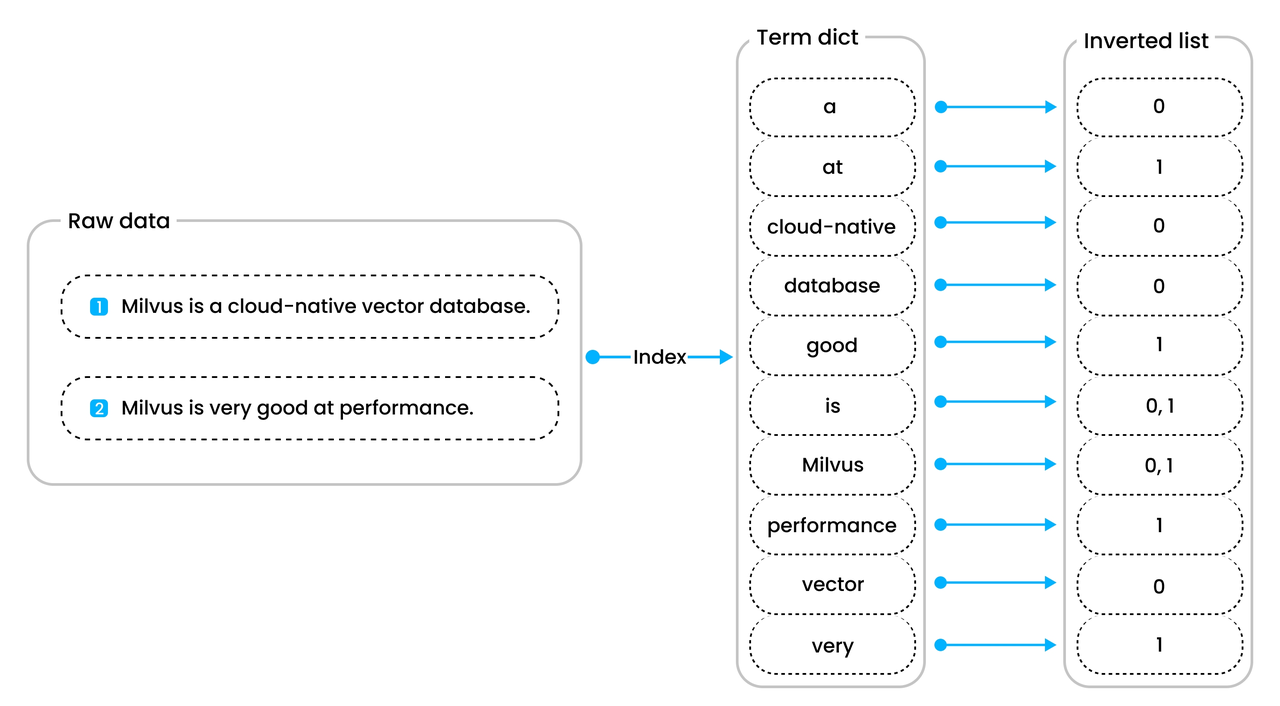INVERTED
The INVERTED index in Milvus is designed to accelerate filter queries on both scalar fields and structured JSON fields. By mapping terms to the documents or records that contain them, inverted indexes greatly improve query performance compared to brute-force searches.
Overview
Powered by Tantivy, Milvus implements inverted indexing to accelerate filter queries, especially for textual data. Here’s how it works:
Tokenize the Data: Milvus takes your raw data—in this example, two sentences:
“Milvus is a cloud-native vector database.”
“Milvus is very good at performance.”
and breaks them into unique words (e.g., Milvus, is, cloud-native, vector, database, very, good, at, performance).
Build the Term Dictionary: These unique words are stored in a sorted list called the Term Dictionary. This dictionary lets Milvus quickly check if a word exists and locate its position in the index.
Create the Inverted List: For each word in the Term Dictionary, Milvus keeps an Inverted List showing which documents contain that word. For instance, “Milvus” appears in both sentences, so its inverted list points to both document IDs.
 Inverted
Inverted
Because the dictionary is sorted, term-based filtering can be handled efficiently. Instead of scanning all documents, Milvus just looks up the term in the dictionary and retrieves its inverted list—significantly speeding up searches and filters on large datasets.
Index a regular scalar field
For scalar fields like BOOL, INT8, INT16, INT32, INT64, FLOAT, DOUBLE, VARCHAR, and ARRAY, creating an inverted index is straightforward. Use the create_index() method with the index_type parameter set to "INVERTED".
from pymilvus import MilvusClient
client = MilvusClient(
uri="http://localhost:19530",
)
index_params = client.create_index_params() # Prepare an empty IndexParams object, without having to specify any index parameters
index_params.add_index(
field_name="scalar_field_1", # Name of the scalar field to be indexed
index_type="INVERTED", # Type of index to be created
index_name="inverted_index" # Name of the index to be created
)
client.create_index(
collection_name="my_collection", # Specify the collection name
index_params=index_params
)
Index a JSON field
Milvus extends its indexing capabilities to JSON fields, allowing you to efficiently filter on nested or structured data stored within a single column. Unlike scalar fields, when indexing a JSON field you must provide two additional parameters:
json_path: Specifies the nested key to index.json_cast_type: Defines the data type (e.g.,"varchar","double", or"bool") to which the extracted JSON value will be cast.
For example, consider a JSON field named metadata with the following structure:
{
"metadata": {
"product_info": {
"category": "electronics",
"brand": "BrandA"
},
"price": 99.99,
"in_stock": true,
"tags": ["summer_sale", "clearance"]
}
}
To create inverted indexes on specific JSON paths, you can use the following approach:
index_params = client.prepare_index_params()
# Example 1: Index the 'category' key inside 'product_info' as a string.
index_params.add_index(
field_name="metadata", # JSON field name
index_type="INVERTED", # Specify the inverted index type
index_name="json_index_1", # Custom name for this JSON index
params={
"json_path": "metadata[\"product_info\"][\"category\"]", # Path to the 'category' key
"json_cast_type": "varchar" # Cast the value as a string
}
)
# Example 2: Index the 'price' key as a numeric type (double).
index_params.add_index(
field_name="metadata", # JSON field name
index_type="INVERTED",
index_name="json_index_2", # Custom name for this JSON index
params={
"json_path": "metadata[\"price\"]", # Path to the 'price' key
"json_cast_type": "double" # Cast the value as a double
}
)
Parameter |
Description |
Example Value |
|---|---|---|
|
Name of the JSON field in your schema. |
|
|
Index type to create; currently only |
|
|
(Optional) A custom index name. Specify different names if you create multiple indexes on the same JSON field. |
|
|
Specifies which JSON path to index. You can target nested keys, array positions, or both (e.g., |
|
|
Data type that Milvus will cast the extracted JSON values to when building the index. Valid values:
|
|
Considerations on JSON indexing
Filtering logic:
If you create a double-type index (
json_cast_type="double"), only numeric-type filter conditions can use the index. If the filter compares a double index to a non-numeric condition, Milvus falls back to brute force search.If you create a varchar-type index (
json_cast_type="varchar"), only string-type filter conditions can use the index. Otherwise, Milvus falls back to brute force.Boolean indexing behaves similarly to varchar-type.
Term expressions:
- You can use
json["field"] in [value1, value2, …]. However, the index works only for scalar values stored under that path. Ifjson["field"]is an array, the query falls back to brute force (array-type indexing is not yet supported).
- You can use
Numeric precision:
- Internally, Milvus indexes all numeric fields as doubles. If a numeric value exceeds , it loses precision, and queries on those out-of-range values may not match exactly.
Data integrity:
- Milvus does not parse or transform JSON keys beyond your specified casting. If the source data is inconsistent (for example, some rows store a string for key
"k"while others store a number), some rows will not be indexed.
- Milvus does not parse or transform JSON keys beyond your specified casting. If the source data is inconsistent (for example, some rows store a string for key